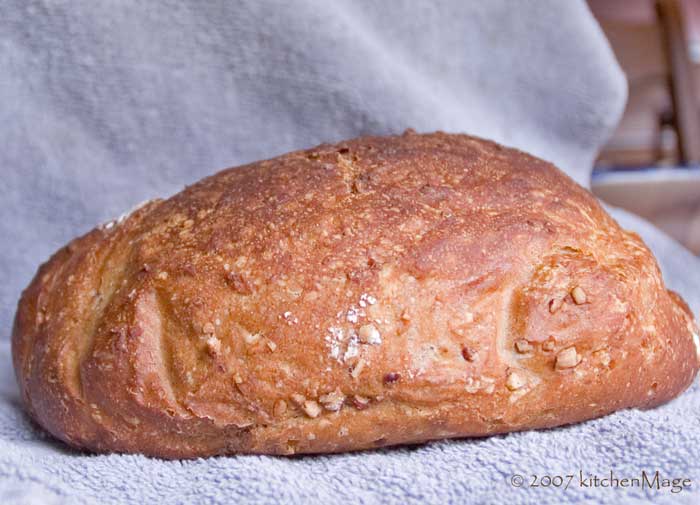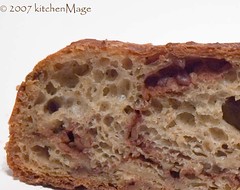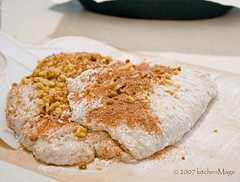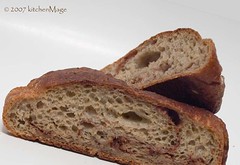Kevin: No-Knead Muffins
Of the three of us hosting this blog, I'm the artiste, while Beth and Susan are technicians. Alternatively, of the three of us Beth and Susan are the dedicated bakers, seeking perfection while I'm the gadfly with the attention span of, well, a gadfly. I prefer the first interpretation but suspect the second is far more accurate.
Nevertheless, one of our goals was to present different approaches to baking bread. My compatriots will make a recipe two or three or more times in a row, tweaking each iteration, until they've nailed it. You can learn a lot from them. Me? I'll make it once, take some notes about what I think worked and didn’t — notes that I often lose — and then not try it again for a year or more if ever. Yeah, gadfly is probably a more accurate description of my approach.
I've been making English muffins for many, many years and although I've produced some superior muffins, I've never produced something as good as what I want. In fact, I've never produced something close to what I want.
Like Beth, I wasn't tremendously impressed with the NY Times No-Knead Bread when I first tried it. It was certainly pretty, but the flavor was on the bland side. and it got stale rapidly. It wasn't suitable for sandwiches, too many huge holes, but given how quickly it became stale that wasn't really an option anyway. Besides, I didn't see that it saved me anything. Kneading only takes 10 minutes and if the long rest between mixing and baking seems like a good idea, then you should know that almost any bread can be refrigerated for 12 hours before baking without harm. In fact, 12 hours in the fridge usually helps the flavor.
Perfect English Muffins
When I was a kid my mother sometimes bought Bay's English Muffins. These gems weren't found with the rest of the breads — or other English Muffins — they were in the dairy compartment near the cheese, eggs, butter, and milk. Exactly were they belonged. I've eaten hundreds, perhaps thousands, of English muffins over the years, and Bay's remains the ideal.
An English muffin is cooked on a griddle — fried, in effect. But it should never taste fried, it should taste baked. And yet, baking wouldn't work. To achieve the proper crust it must be exposed to direct heat.
Split an English muffin open and ideally you should see a moonscape of large and small craters, these craters are perfect for collecting puddles of sweet butter and capturing snags of marmalade.
Bite into one and, unlike most bread — or English muffins for that matter — and you find you need your incisors to tear off a piece like picking up a steak and tearing off a bite. And like steak, you have to chew it.
A truly good English muffin has a noticeably sour note to it. A flavor that blends with something like orange marmalade and highlights a topping such as strawberry jam. Butter is its heart-mate.
I immediately decided I needed to try the recipe as a muffin.
Step one was to get some muffin rings. None of the muffins I'd made in the past needed rings. They were sturdy enough to shape and then rise on their own, but using the no-knead recipe would produce pancakes, not muffins — unless the dough was confined. I ordered some muffin rings and they disappeared into a cabinet until this past Sunday.
On Sunday I mixed the dough according to the recipe except that I rounded off the water to 1 1/2 cups (what's with this 5/8 cup nonsense?) and then followed Beth's suggestion and covered the bowl with plastic and refrigerated it for about 15 hours.
On Monday I pulled it from the fridge and let it warm for an hour and a half. Bad move. Although the dough was still cold, it was too warm for easy shaping. Nevertheless, I pressed on and dusted my aluminum peel with a heavy coating of corn meal, arranged nine rings on it. I dusted my baker's mat heavily with flour and rolled the dough into a cylinder about 12 inches long. Actually, not so much a cylinder as a puffy, sort of rectangular pancake 12 inches long — this stuff is as hard to control as a two-year-old.
No Fear
I didn't screw up my first batch of muffins on purpose. But I did make them knowing I'd screw up. I even suspected some of the ways I'd screw up. But this effort was an experiment. I wanted to learn and that meant I needed to know what could go wrong.
I believed Beth when she said shaping the dough cold was a good idea, but how cold? So I let it warm up some and then tried it. Bad idea. I learned to do it straight from the fridge.
With most breads you let them double in bulk before cooking, but I didn't know how that translated to a slack dough in a ring. So for my first batch I tried several degrees of filling and rising. The conventional wisdom proved correct — fill each ring half way (more or less) and cook when the rings are filled with risen dough.
I also learned that this dough is probably too wet for this purpose, I'll use a bit more flour on my next effort and knead the additional flour by had to understand the texture I want.
I baked my first brick 40 years ago, I'm still learning. Never be afraid of learning.
I should have anticipated the next problem. But didn't. The muffins stuck to the plastic. Unsticking them was a delicate operation, but I accomplished it and they went onto a griddle lightly brushed with lard. Sadly, they didn’t slide neatly off the foil. Despite the generous layer of corn meal they stuck to the peel too, so I had to use a spatula tomove them from peel to griddle.
Another problem. Although I was careful to use very little fat, I still used too much and the muffins fried. That didn't hurt the flavor, but did hurt the texture of the crust. I made a note to use a paper towel to wipe the griddle after oiling it for the second batch.
Last error. I should have greased the insides of the muffin rings. Actually, it did cross my mind, but for some reason (I'm not sure why) I didn't. I had to run a knife around the inside of the rings to free the muffins, which destroyed their edges.
So, given all these problems, what was the result? A decent muffin. Not great, the crust was too crisp and they were too thin, but the holes I'd desired for so many years were there as was the chewy texture. The flavor? Not so great.
I'd wrapped the unused dough in plastic and put it back in the refrigerator. So the next day I unwrapped it and made a second batch and allowed for my earlier problems. So I:
- didn't allow the dough to warm up at all before forming the patties
- filled the rings half way and cooked them when the dough hit the plastic
- coated peel with both flour and corn meal
- buttered the inside of muffin rings
- dusted the tops of the muffins with flour to at least minimize sticking to the plastic
- wiped the griddle with a paper towel so only a trace of oil remained
As you can see from the photo, the second batch of muffins is gorgeous. The .8-ounce weaklings became 1-ounce giants.
Perfection though? Nope. And perhaps some difficulties are inevitable. Despite the addition of flour to the cornmeal underneath the muffins I still needed a spatula to get them off the peel, but I accomplished that with much less damage to the muffin. There was also still some sticking to the plastic covering, but, again, much less sticking resulting in less damage to the muffin's structure.
Half of the muffins simply slipped from their rings when I used tongs to turn them over, and the others only stuck because a bit of dough overlapped the ring. They were easily freed.
The crust is still a tad crisper than I'd prefer and although several solutions occur to me, I want to think on it further.
The second batch did taste a bit better, but I can put that down to the longer stay in the fridge and to more air in the muffin. The flavor wasn't significantly improved. This dough is bland — and doesn’t keep well.
But I learned I want a slack dough. I learned (thanks Beth) that it should be formed cold. I learned how to use muffin rings. And I learned that choosing a good marmalade for your breakfast muffin is essential. Actually, I already knew that last one.
Technorati: Food | recipe | baking | bread | artisanal | artisan | bread baking | noKnead bread | english muffins
Labels: English, english muffins, Kevin, noKnead bread
Click here to continue reading the post and comments...









 Click here to see A Year of Bread in pictures."
Click here to see A Year of Bread in pictures."